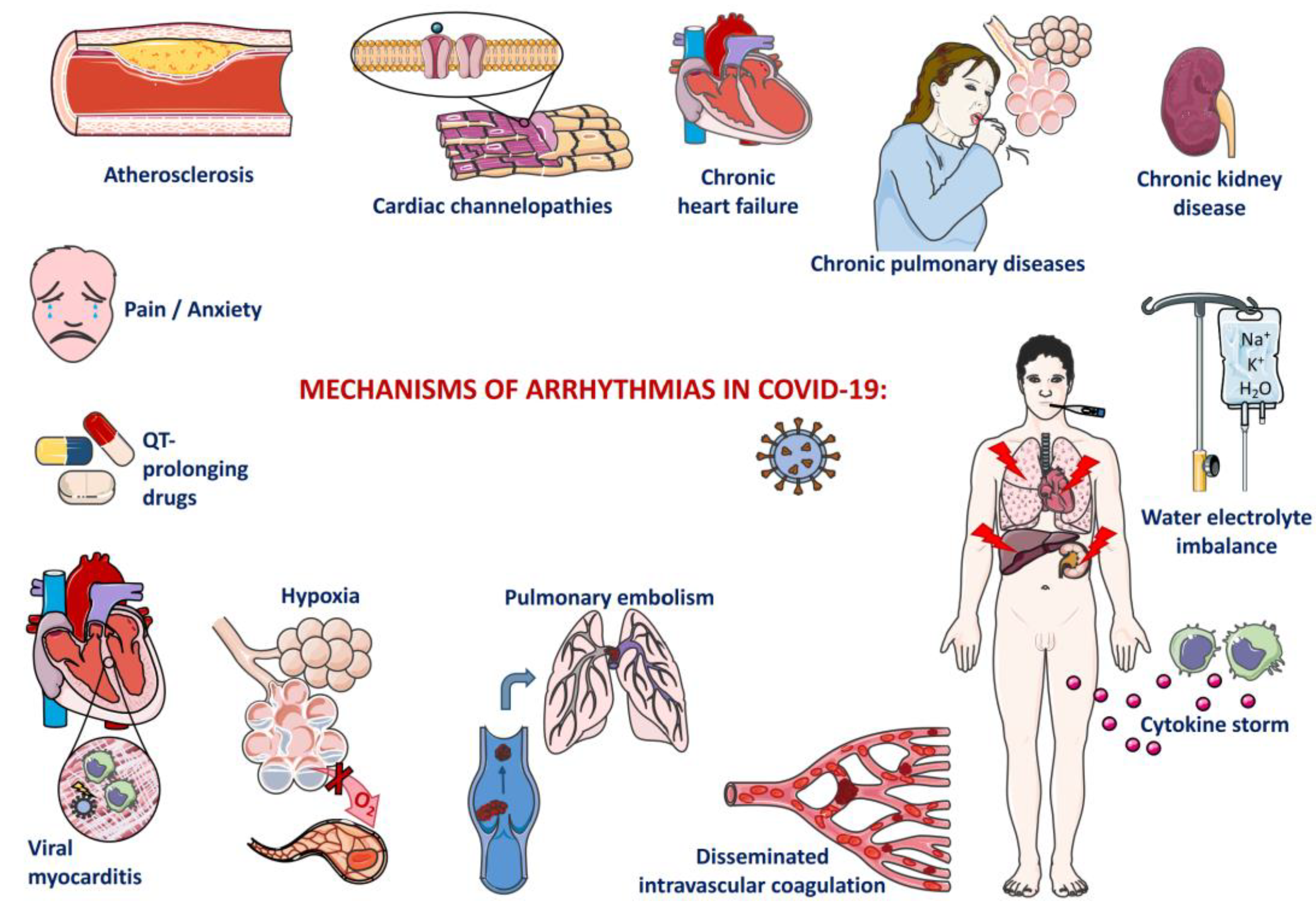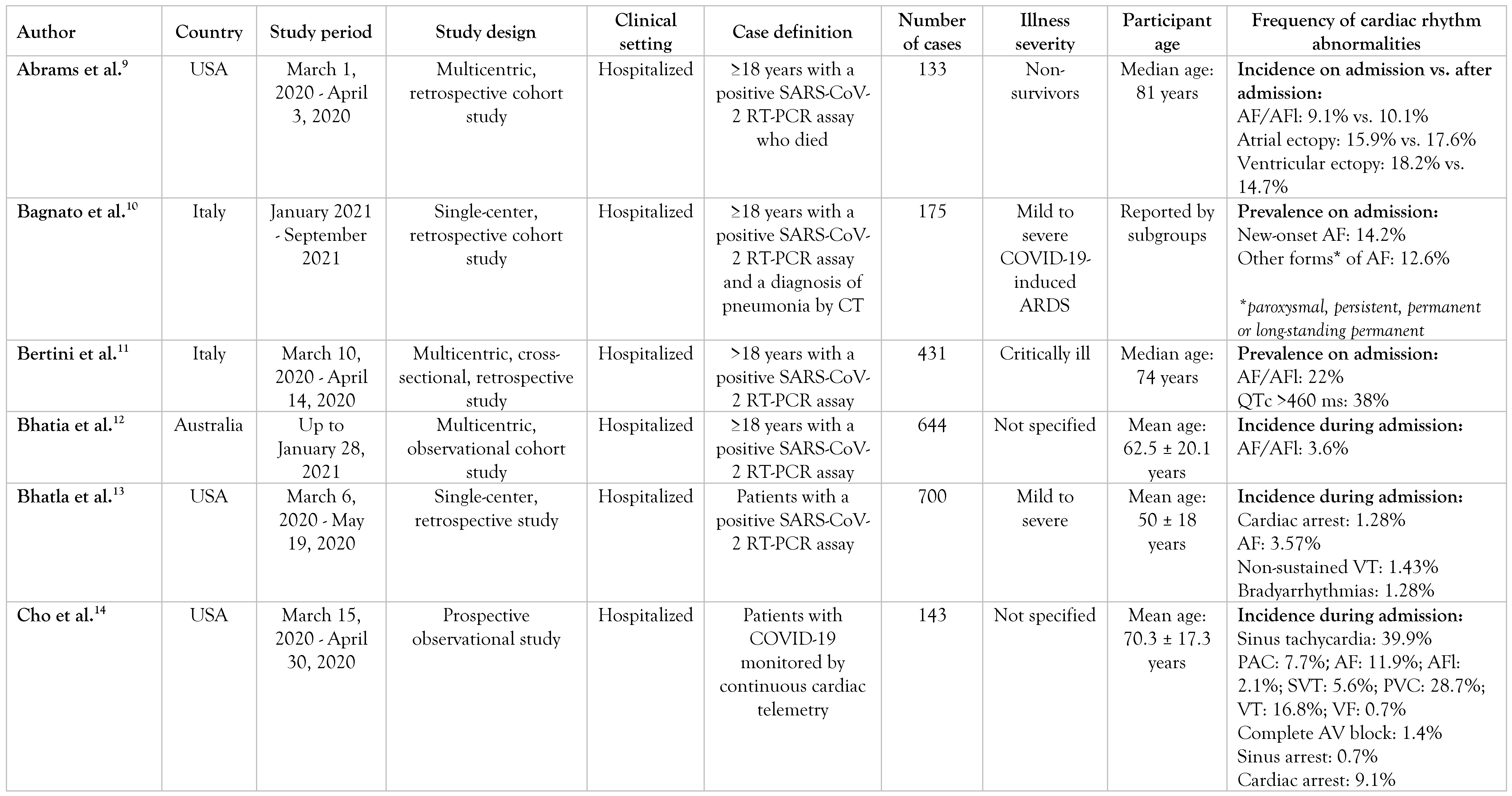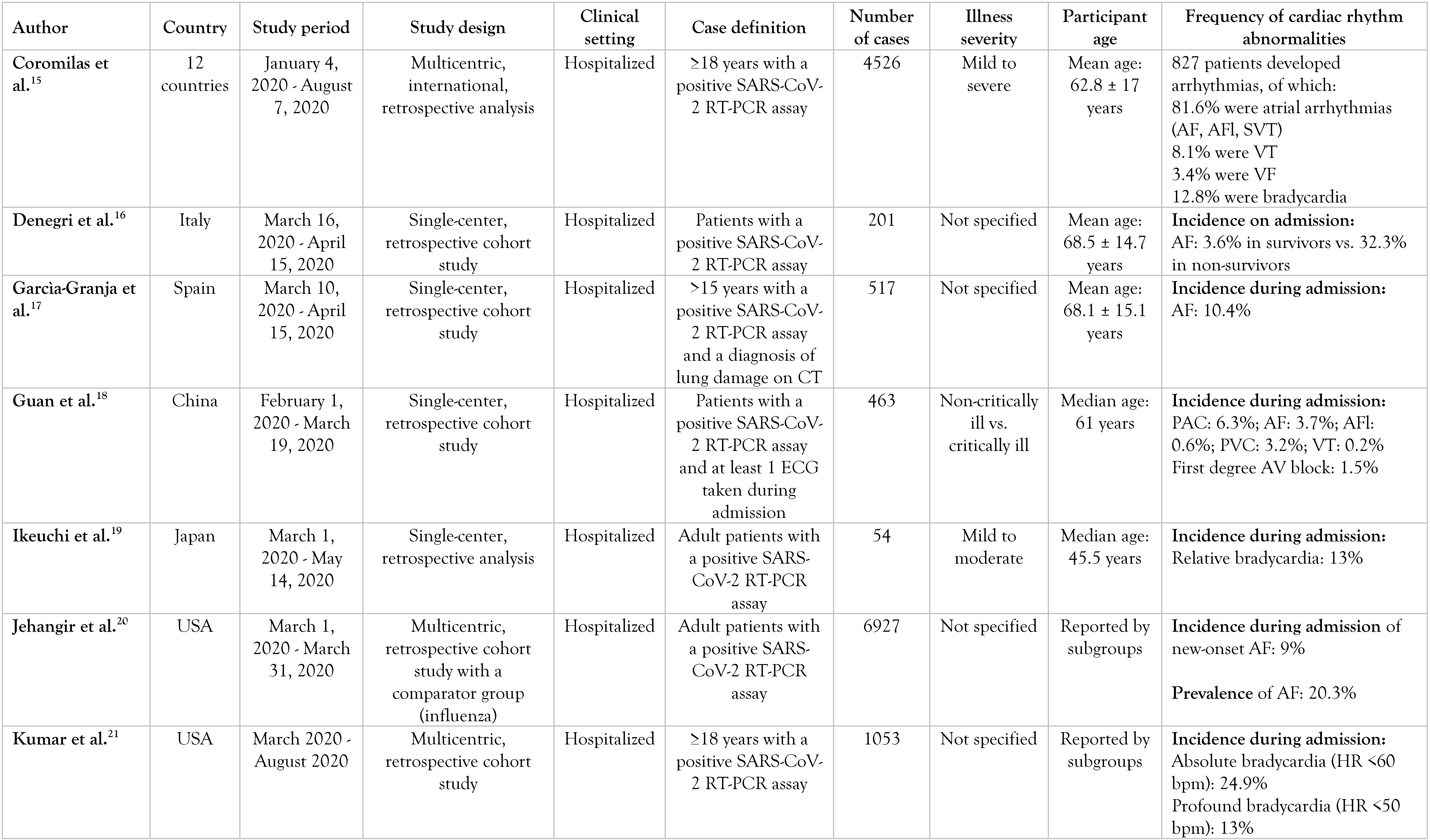Pathophysiological Correlations Between SARS-CoV-2 and Arrhythmogenesis: A Literature Review
Abstract
Introduction
Methods
Search strategy
Inclusion/exclusion criteria
Data analysis
Results
General findings in COVID-19 studies
Studies conducted on pediatric patients with COVID-19
Studies about absolute and relative bradycardia in COVID-19
Discussion
Conclusions
Author Contributions
Funding
Data Availability Statement
Conflicts of interest
References
- Magadum, A.; Kishore, R. Cardiovascular manifestations of COVID-19 infection. Cells. 2020, 9, 2508. [Google Scholar] [CrossRef]
- Raman, B.; Bluemke, D.A.; Lüscher, T.F.; Neubauer, S. Long COVID: Post-acute sequelae of COVID-19 with a cardiovascular focus. Eur Heart J. 2022, 43, 1157–1172. [Google Scholar] [CrossRef]
- Felsenstein, S.; Herbert, J.A.; McNamara, P.S.; Hedrich, C.M. COVID-19: Immunology and treatment options. Clin Immunol. 2020, 215, 108448. [Google Scholar] [CrossRef] [PubMed]
- Clerkin, K.J.; Fried, J.A.; Raikhelkar, J.; et al. COVID-19 and cardiovascular disease. Circulation. 2020, 141, 1648–1655. [Google Scholar] [CrossRef]
- Hu, B.; Guo, H.; Zhou, P.; Shi, Z.L. Characteristics of SARS-CoV-2 and COVID-19. Nat Rev Microbiol. 2021, 19, 141–154. [Google Scholar] [CrossRef]
- Thum, T. SARS-CoV-2 receptor ACE2 expression in the human heart: Cause of a post-pandemic wave of heart failure? Eur Heart J. 2020, 41, 1807–1809. [Google Scholar] [CrossRef]
- Bojkova, D.; Wagner, J.U.G.; Shumliakivska, M.; et al. SARS-CoV-2 infects and induces cytotoxic effects in human cardiomyocytes. Cardiovasc Res. 2020, 116, 2207–2215. [Google Scholar] [CrossRef]
- Lindner, D.; Fitzek, A.; Bräuninger, H.; Aleshcheva, G.; Edler, C.; Meissner, K.; et al. Association of cardiac infection with SARS-CoV-2 in confirmed COVID-19 autopsy cases. JAMA Cardiol. 2020, 5, 1281–1285. [Google Scholar] [CrossRef] [PubMed]
- Abrams, M.P.; Wan, E.Y.; Waase, M.P.; et al. Clinical and cardiac characteristics of COVID-19 mortalities in a diverse New York City Cohort. J Cardiovasc Electrophysiol. 2020, 31, 3086–3096. [Google Scholar] [CrossRef] [PubMed]
- Bagnato, G.; Imbalzano, E.; Aragona, C.O.; et al. New-onset atrial fibrillation and early mortality rate in COVID-19 patients: Association with IL-6 serum levels and respiratory distress. Medicina (Kaunas). 2022, 58, 530. [Google Scholar] [CrossRef]
- Bertini, M.; Ferrari, R.; Guardigli, G.; et al. Electrocardiographic features of 431 consecutive, critically ill COVID-19 patients: An insight into the mechanisms of cardiac involvement. Europace. 2020, 22, 1848–1854. [Google Scholar] [CrossRef]
- Bhatia, K.S.; Sritharan, H.P.; Chia, J.; et al. Cardiac complications in patients hospitalised with COVID-19 in Australia. Heart Lung Circ. 2021, 30, 1834–1840. [Google Scholar] [CrossRef]
- Bhatla, A.; Mayer, M.M.; Adusumalli, S.; et al. COVID-19 and cardiac arrhythmias. Heart Rhythm. 2020, 17, 1439–1444. [Google Scholar] [CrossRef]
- Cho, J.H.; Namazi, A.; Shelton, R.; et al. Cardiac arrhythmias in hospitalized patients with COVID-19: A prospective observational study in the western United States. PLoS ONE. 2020, 15, e0244533. [Google Scholar] [CrossRef] [PubMed]
- Coromilas, E.J.; Kochav, S.; Goldenthal, I.; et al. Worldwide Survey of COVID-19-associated arrhythmias. Circ Arrhythm Electrophysiol. 2021, 14, e009458. [Google Scholar] [CrossRef] [PubMed]
- Denegri, A.; Pezzuto, G.; D’Arienzo, M.; et al. Clinical and electrocardiographic characteristics at admission of COVID-19/SARS-CoV2 pneumonia infection. Intern Emerg Med. 2021, 16, 1451–1456. [Google Scholar] [CrossRef] [PubMed]
- García-Granja, P.E.; Veras, C.; Aparisi, Á.; et al. Atrial fibrillation in patients with SARS-CoV-2 infection. Med Clin (Barc). 2021, 157, 58–63. [Google Scholar] [CrossRef]
- Guan, H.; Liu, J.; Ding, J.; et al. Arrhythmias in patients with coronavirus disease 2019 (COVID-19) in Wuhan, China: Incidences and implications. J Electrocardiol. 2021, 65, 96–101. [Google Scholar] [CrossRef]
- Ikeuchi, K.; Saito, M.; Yamamoto, S.; Nagai, H.; Adachi, E. Relative bradycardia in patients with mild-to-moderate coronavirus disease, Japan. Emerg Infect Dis. 2020, 26, 2504–2506. [Google Scholar] [CrossRef]
- Jehangir, Q.; Lee, Y.; Latack, K.; et al. Incidence, mortality, and imaging outcomes of atrial arrhythmias in COVID-19. Am J Cardiol. 2022, 173, 64–72. [Google Scholar] [CrossRef]
- Kumar, S.; Arcuri, C.; Chaudhuri, S.; et al. A novel study on SARS-COV-2 virus associated bradycardia as a predictor of mortality-retrospective multicenter analysis. Clin Cardiol. 2021, 44, 857–862. [Google Scholar] [CrossRef]
- Oliva, A.; Franchi, C.; Gatto, M.C.; Galardo, G.; Pugliese, F.; Mastroianni, C. Prevalence and clinical significance of relative bradycardia at hospital admission in patients with coronavirus disease 2019 (COVID-19). Clin Microbiol Infect. 2021, 27, 1185–1187. [Google Scholar] [CrossRef]
- Peltzer, B.; Manocha, K.K.; Ying, X.; et al. Outcomes and mortality associated with atrial arrhythmias among patients hospitalized with COVID-19. J Cardiovasc Electrophysiol. 2020, 31, 3077–3085. [Google Scholar] [CrossRef]
- Poterucha, T.J.; Elias, P.; Jain, S.S.; et al. Admission cardiac diagnostic testing with electrocardiography and troponin measurement prognosticates increased 30-day mortality in COVID-19. J Am Heart Assoc. 2021, 10, e018476. [Google Scholar] [CrossRef] [PubMed]
- Regan, W.; O’Byrne, L.; Stewart, K.; et al. Electrocardiographic changes in children with multisystem inflammation associated with COVID-19: Associated with coronavirus disease 2019. J Pediatr. 2021, 234, 27–32.e2. [Google Scholar] [CrossRef] [PubMed]
- Samuel, S.; Friedman, R.A.; Sharma, C.; et al. Incidence of arrhythmias and electrocardiographic abnormalities in symptomatic pediatric patients with PCR-positive SARS-CoV-2 infection, including drug-induced changes in the corrected QT interval. Heart Rhythm. 2020, 17, 1960–1966. [Google Scholar] [CrossRef] [PubMed]
- Si, D.; Du, B.; Ni, L.; et al. Death, discharge and arrhythmias among patients with COVID-19 and cardiac injury. CMAJ. 2020, 192, E791–E798. [Google Scholar] [CrossRef]
- Wakabayashi, T.; Iwata, H. The clinical utility of relative bradycardia for identifying cases of coronavirus disease 2019 pneumonia: A retrospective pneumonia cohort study. Intern Med. 2023, 62, 1931–1938. [Google Scholar] [CrossRef]
- Wetterslev, M.; Jacobsen, P.K.; Hassager, C.; et al. Cardiac arrhythmias in critically ill patients with coronavirus disease 2019: A retrospective population-based cohort study. Acta Anaesthesiol Scand. 2021, 65, 770–777. [Google Scholar] [CrossRef]
- Zakynthinos, G.E.; Tsolaki, V.; Karavidas, N.; et al. Secondary bacterial infections are a leading factor triggering New Onset Atrial Fibrillation in intubated ICU Covid-19 ARDS patients. J Infect Public Health. 2022, 15, 766–772. [Google Scholar] [CrossRef] [PubMed]
- Duckheim, M.; Schreieck, J. COVID-19 and cardiac arrhythmias. Hamostaseologie. 2021, 41, 372–378. [Google Scholar] [CrossRef] [PubMed]
- Malaty, M.; Kayes, T.; Amarasekera, A.T.; Kodsi, M.; MacIntyre, C.R.; Tan, T.C. Incidence and treatment of arrhythmias secondary to coronavirus infection in humans: A systematic review. Eur J Clin Invest. 2021, 51, e13428. [Google Scholar] [CrossRef] [PubMed]
- Wu, C.I.; Postema, P.G.; Arbelo, E.; et al. SARS-CoV-2, COVID-19, and inherited arrhythmia syndromes. Heart Rhythm. 2020, 17, 1456–1462. [Google Scholar] [CrossRef] [PubMed]
- Cascella, M.; Rajnik, M.; Aleem, A.; Dulebohn, S.C.; Di Napoli, R. Features, evaluation, and treatment of Coronavirus (COVID-19). 2023. In StatPearls; StatPearls Publishing: Treasure Island, FL, USA, 2024. [Google Scholar]
- Patel, N.H.; Rutland, J.; Tecson, K.M. Arrhythmias and intraventricular conduction disturbances in patients hospitalized with coronavirus disease 2019. Am J Cardiol. 2022, 162, 111–115. [Google Scholar] [CrossRef]
- Manolis, A.S.; Manolis, A.A.; Manolis, T.A.; Apostolopoulos, E.J.; Papatheou, D.; Melita, H. COVID-19 infection and cardiac arrhythmias. Trends Cardiovasc Med. 2020, 30, 451–460. [Google Scholar] [CrossRef]
- Kasper, D.L.; Fauci, A.S.; Hauser, S.L.; Longo, D.L.; Jameson, J.L.; Loscalzo, J. Harrison’s principles of internal medicine. 19th Edition. McGraw-Hill Education; 2015.
- Dherange, P.; Lang, J.; Qian, P.; et al. Arrhythmias and COVID-19: A review. JACC Clin Electrophysiol. 2020, 6, 1193–1204. [Google Scholar] [CrossRef]
- Pijls, B.G.; Jolani, S.; Atherley, A.; et al. Demographic risk factors for COVID-19 infection, severity, ICU admission and death: A meta-analysis of 59 studies. BMJ Open. 2021, 11, e044640. [Google Scholar] [CrossRef] [PubMed]
- Bryce, Y.C.; Perez-Johnston, R.; Bryce, E.B.; Homayoon, B.; Santos-Martin, E.G. Pathophysiology of right ventricular failure in acute pulmonary embolism and chronic thromboembolic pulmonary hypertension: A pictorial essay for the interventional radiologist. Insights Imaging. 2019, 10, 18. [Google Scholar] [CrossRef]


    |
© GERMS 2024.
Share and Cite
Junghetu, M.A.; Bălăşescu, E.; Stratan, L.M.; Ion, D.A. Pathophysiological Correlations Between SARS-CoV-2 and Arrhythmogenesis: A Literature Review. GERMS 2024, 14, 63-76. https://doi.org/10.18683/germs.2024.1418
Junghetu MA, Bălăşescu E, Stratan LM, Ion DA. Pathophysiological Correlations Between SARS-CoV-2 and Arrhythmogenesis: A Literature Review. GERMS. 2024; 14(1):63-76. https://doi.org/10.18683/germs.2024.1418
Chicago/Turabian StyleJunghetu, Maria Alexandra, Elena Bălăşescu, Laurenţiu Mihăiţă Stratan, and Daniela Adriana Ion. 2024. "Pathophysiological Correlations Between SARS-CoV-2 and Arrhythmogenesis: A Literature Review" GERMS 14, no. 1: 63-76. https://doi.org/10.18683/germs.2024.1418
APA StyleJunghetu, M. A., Bălăşescu, E., Stratan, L. M., & Ion, D. A. (2024). Pathophysiological Correlations Between SARS-CoV-2 and Arrhythmogenesis: A Literature Review. GERMS, 14(1), 63-76. https://doi.org/10.18683/germs.2024.1418




